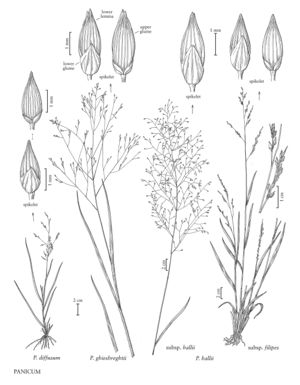Panicum ghiesbreghtii
Plants perennial; cespitose. Culms 40-120 cm tall, 2-3 mm thick, decumbent to erect, branching from the base and the middle nodes; nodes pilose, hairs spreading; internodes hirsute, hairs papillose-based. Sheaths usually shorter than the internodes, hirsute, lower sheaths more so than those above, hairs papillose-based; collars densely pilose; ligules 0.5-4 mm; blades 16-55 cm long, 0.5-14 mm wide, erect to ascending, abaxial surfaces hirsute, hairs papillose-based, adaxial surfaces densely pilose, midveins prominent and whitish, bases truncate, margins ciliate basally, apices attenuate. Terminal panicles 7-35 cm long, 5-23 cm wide, about 1/2 as wide as long, shortly exerted or partially included, lax, open; axillary panicles smaller, included basally; primary branches diverging, lower branches solitary, upper branches solitary to subverticillate; secondary branching primarily in the distal 1/3; pedicels 1-4 mm, clavate, spreading to appressed. Spikelets 2.6-3.4 mm long, 0.9-1.2 mm wide, ovoid, glabrous. Lower glumes 1.4-1.7 mm, to 1/2 as long as the spikelets, acute, 5-7-veined; upper glumes and lower lemmas similar, exceeding the upper florets by 0.7-0.9 mm, 9-13-veined; lower florets sterile; lower paleas 0.5-1.3 mm; upper lorets 1.7-2.3 mm long, 0.8-1.1 mm wide, smooth, ovoid. 2n = unknown.
Distribution
Puerto Rico, Tex.
Discussion
Panicum ghiesbreghtii grows in low, moist ground, wet thickets, and savannahs, from southern Texas through Mexico, Central America, Cuba, and the West Indies to northern South America.
Selected References
None.
Lower Taxa
"decumbent" is not a number."-11-veined" is not declared as a valid unit of measurement for this property.
